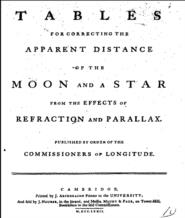
NavList:
A Community Devoted to the Preservation and Practice of Celestial Navigation and Other Methods of Traditional Wayfinding
From: Ken Muldrew
Date: 2016 Jan 14, 20:03 -0700
There are about 300,000 values that were computed for these tables. A lot of work.Thanks Ken,
that is even more amazing! Human computers did what must have been thousands of lunar clearance calculations, old style to get that?
Yes, the curves appear to be differentiable (smooth) and the derivative often changes slowly so he could have skipped a lot of points just by drawing a fair curve, but the dotted curves have the same properties and a point is obviously drawn for each degree, so maybe he drew them all.Presumably, Margett "simply" chose a limited number of results from the tables and made fair curves through those data points to obtain the intermediate results by visual interpolation? Either way, what an immense achievement for the 1770s!
They were at one time, but perhaps only by subscription now. I'll attach the front page as the proper title may help you in your search. The pdf is 100MB. Let me know if you still can't find them and we can figure out a way for me to send you a copy.Any idea if these tables are available digitally on line? I've had a quick look on the Cambridge libraray web site but could not find one.
I used them a bit more after those postings but I haven't used them recently. The graphs themselves are very accurate for clearing lunars but navigators still had to get the position of the moon from the nautical almanac. Those computations were based on Mayer's original publication of the lunar position which could give errors in the moon's position of up to 30" quite frequently.Also, you mentioned back in 2006 some of your test results. Have you done any since? If the graphs are based on 1772, Lyon/Shephard tables, then do you or maybe Frank know how accurate they were then compared to more recent tables? Presumably the maths of clearance was correct then even if there were some inaccuracies of final result due to errors of actual lunar postions etc which were improved over subsequent years?







